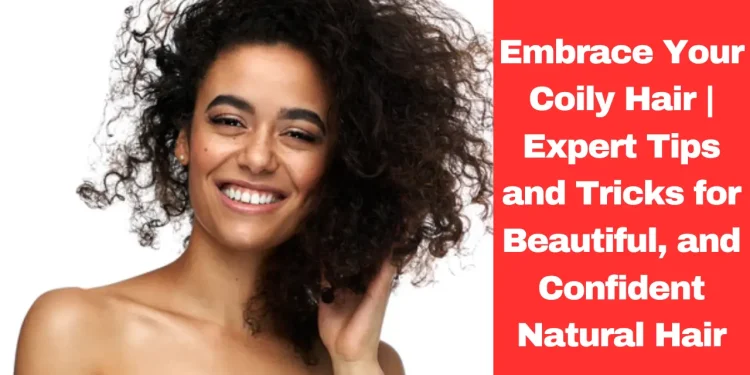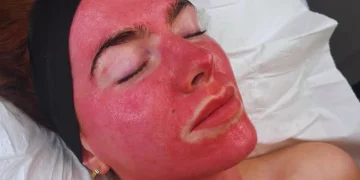Curly hair may seem unattractive in a society that values straight, sleek hair. In recent years, more individuals have worn their hair natural, including in coils. Coily hair is stunning, one of a kind, and needs special attention in order to flourish. In this article, we’ll give you professional tips on how to care for curly hair, style it, and, most importantly, appreciate its unique charm. C’mon, let’s just jump right in!
Understanding Coily Hair
The different types of coily hair (Type 4a, 4b, and 4c)
Andre Walker’s hair type 4 is curly. Type 4 hair has pencil-sized to corkscrew-sized curls. Types 4a–4c exist.
- 4A hair features tight “S” curls. These curls stand out. Dry, fine 4A hair.
- 4b hair has a weaker “Z” pattern than 4a. Pointy coils are asymmetrical and tight. 4B hair is denser, thicker, and shorter than 4A hair.
- Most compact and fine is type 4C coiled hair. Curls zigzag. 4C hair has fewer kinks than 4B hair. Its delicate textures show.
Characteristics of coily hair
Coily hair has unique properties. These qualities include:
- Coily hair has close-packed, varying-sized curls or coils.
- Curly hair is dry because its tight coils prevent natural oils from entering.
- Coily hair shrinks quickly, making it seem shorter when dried.
- Curly hair is the most fragile due to its tightly coiled form.
- Tangled and broken coily hair is more likely to break than straighter styles.
- Every hair requires moisture to keep healthy and prevent breaking, including coily hair. Coily hair needs regular, thorough conditioning and moisturizing.
- Due to its flexibility, coily hair may be styled in twist-outs, braids, and bantu knots.
Common challenges with coily hair
Coily hair is stunning, but it has its drawbacks. Coily hair issues include:
- The way curly hair is made keeps natural oils from getting into the hair shaft.
- The most fragile kind of hair is coily.
- Curly hair shrinks a lot, making it difficult to style.
- Naturally curly or coily hair may become tangled and knotted, making styling difficult.
- Frizz is more prevalent on greasy hair in humid weather.
- Curly hair may dry out and irritate the scalp.
- Curly-haired folks may feel discouraged since they have fewer style choices.
Expert Tips for Coily Hair Care
Importance of moisture
Dry hair requires more hydration. Natural oils cannot penetrate coily hair’s tightly coiled cuticle and nurture the strands. Dehydration may dry out and damage hair coils.
Hydrate curly hair. They hydrate curly hair:
Deep conditioning may reduce oily hair.
Co-washing with conditioner instead of shampoo preserves hair oils and prevents dryness.
Leave-in conditioners soften oily hair.
Water-rich products moisturize curly hair.
Braids, twists, and bantu knots protect coily hair.
Pillows and hair covers made of satin or silk protect curly hair from cotton and other fabrics that can dry it out.
Choosing the right products
Product choice maintains coily hair’s health and attractiveness. Curly hair shopping tips:
- Glycerin, aloe vera, and shea butter prevent hair dryness.
- Sulfates, alcohols, and silicones dry hair. Avoid these for curly hair.
- Low, medium, and high porosity impact water retention in curly hair. Lighter treatments allow light to pass through, while heavy ones trap moisture.
- Natural solutions nourish curly hair without breaking. honey, coconut oil, and jojoba oil.
- Style matters: Twist-outs, bantu knots, and wash-and-gos suit hair. Style your purchases.
- Before buying, read coily-haired reviews. This may aid your hair care selection.
Detangling coily hair without damage
To prevent breakage, detangle curly hair. Here are some mild procedures for detangling curly hair.
Detangle your hair gently using a wide-tooth comb or flexible-bristled detangling brush.
Detangle knots and tangles carefully from the ends up.
Use a leave-in conditioner or detangling spray to soften and detangle your hair.
Divide your hair into manageable pieces and untangle each section. This reduces knots and tangles.
Before detangling, use a hydrating conditioner to soften and comb your hair.
Avoid damage by carefully untangling knots. Gently separate your hair from the ends using your fingers.
Wear your hair in a braid, twist, or bantu knot to avoid tangles.
Curly hair is easy to disentangle in the shower or after soaking.
Protective styling for coily hair
Prevention safeguards hair. Protective curls:
- Braids on the shield curl. This hairstyle may be made into box braids, cornrows, or twists. Braids last for weeks without effort.
- Two-strand twists preserve curls, too. These treatments last weeks on wet and dry hair. Updos, twist-outs, and bantu knots may twist.
- Wigs and weaves let you explore without destroying your hair. These might be genuine or synthetic hair in various textures and lengths.
- Twisting and wrapping little hair parts creates protective bantu knots.
- One style is a bantu knot-out.
- Updos protect ends. Tall buns or little chignons are updos.
Nighttime hair care routine for coily hair
Coily hair needs nightly care to be healthy, hydrated, and frizz-free. Nighttime curly hair care might include:
- Before bed, carefully disentangle your hair with a wide-tooth comb or your fingers. This prevents tangling overnight.
- Use a moisturizing leave-in conditioner or hair oil on your ends.
- This helps keep moisture overnight.
- Before going to bed, braid or twist your hair to minimize tangles and breakage.
- Sleep with a silk or satin scarf or hat to avoid hair tangling and breaking. Satin and silk don’t absorb moisture and dry your hair.
- Instead of sleeping with a scarf or hat, use a satin or silk pillowcase. Friction reduction prevents knots and breaking.
Styling Coily Hair
Curly hair may be hard to smooth and sleek. Curly hair care:
- Use hair-type-specific shampoo and conditioner.
- Curly hair needs moisture-rich shampoo and conditioner.
- Leave-in conditioners help hair stay moisturized between washes. Benefits include no breakage or split ends.
- Employ a hair-type-appropriate curl-defining cream, gel, or mousse. Distribute it evenly through your hair, focusing on the lengths.
- Detangle and style your hair with gentle tools like fingers or a wide-tooth comb. Protect fine-toothed brushes and combs.
- Change tactics: Try the wash-and-go, twist-out, braid-out, and updo to find your favorite. These styles help tame curls.
- Sleeping with a satin or silk scarf or bonnet may prevent frizz and damage.
Overcoming Insecurities and Building Confidence
Curly-haired people, especially those from straight-haired societies, may feel self-conscious. Self-esteem and coily hair concerns may be addressed. Some advice:
- Find out: Discover hair care. You’ll love your hair and gain style confidence.
- Discover natural-haired role models. Coil-proud folks tweet.
- Haircare is self-care. Use nice products and style your hair.
- Try fresh haircuts that boost your self-esteem. Be adventurous.
- Don’t compare the hair—all of it is distinct. Evaluate your hair’s distinctiveness.
- Self-acceptance includes hair acceptance. Appreciate coils every day.
Conclusion
In the end, learning to love and take care of your natural coils may be a fun way to grow as a person. Curly hair might be difficult, but with the appropriate products, attitude, and knowledge, you can feel confident and appealing. Using the right products and loving yourself may help you accept your coily hair. Always keep in mind that your own hairstyle is something to be cherished and embraced. So, rock those coils and be proud of your hair texture!














